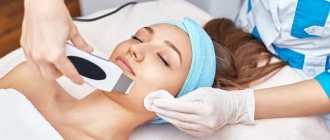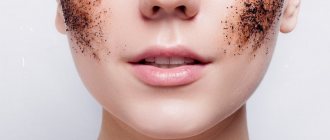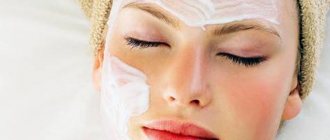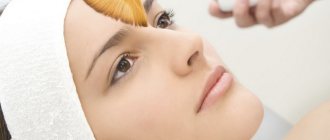What is the difference: home peeling and peeling at a cosmetologist
Peels that can be used at home do not penetrate deeply into the skin and give an unnoticeable result, but they certainly help maintain an even tone and healthy skin. Chemical peels performed by estheticians have a lower pH level than at-home peels, so they can penetrate much deeper into the skin and target skin problems such as hyperpigmentation and acne. Chemical peels can cause redness of the skin; a recovery period will last for several days, during which the “old” skin will gradually peel off and renewed skin will appear.
Chemical peeling performed by cosmetologists will be much more effective for your skin than peeling at home.
Types of all-season facial peels
No matter what all-season facial peelings we are talking about, these are always only superficial peels. The removal of rough skin cells is carried out either mechanically or chemically. Both have their own advantages and disadvantages. In the second case, the skin is not injured, so in terms of safety, chemical peels are preferable.
Due to the fact that the mechanical impact on the skin leaves microcracks, there is a possibility of infection - to prevent this, you need to carefully care for the skin after such peeling.
Contraindications:
- The procedure is not recommended for pregnant and lactating women;
- When taking medications based on isotretinoin;
- For herpes and skin diseases;
- When taking antibiotics;
- For oncological diseases;
- For open wounds.
After a chemical peel, the skin is more sensitive to sunlight, so after the procedure it is necessary to use sunscreens and products.
Before the procedure, the cosmetologist must take into account many factors and ask all the necessary questions so that the procedure is as comfortable as possible for the client and gives the best result with the fewest possible side effects.
When is the best time to do it?
It would seem that taking care of your beauty should be daily or at least several times a week. However, if we are talking about such a thing as facial peeling, then everything is not so arbitrary. Let's look at the season first.
It is generally accepted that only a madman would decide to peel his face in the summer. In part, there is some truth in these words. The fact is that such cleaning removes the top protective layer, that is, the skin literally becomes bare. Accordingly, active exposure to sunlight will certainly not have a positive effect on it. Ultraviolet radiation will provoke aging of the dermis, worsen its general condition, and definitely no one wants to get sunburned. Therefore, facial peeling is carried out mainly in the autumn-winter period, when the effect of ultraviolet radiation is not so active. Of course, now there are more gentle techniques, after which the skin is not so susceptible to the sun. Some manipulations can be carried out in spring and even summer. Regardless of what season you are going for the procedure, it is better to make sure you have sunscreen.
Now let's talk about age criteria. Everything is not so strict here. Peeling is available to absolutely all groups. During adolescence, it perfectly helps fight unwanted acne, which definitely does not add attractiveness. This type of cleansing is recommended for older people, as after it the skin begins to renew itself. This is a great opportunity to maintain youth without any “beauty injections.” Of course, there is no need to go to extremes. At a very young age, it is better not to use such aggressive methods.
Regarding the time of day. There are no restrictions. On the one hand, you can go in the morning, before the skin has time to pick up all sorts of dust and other impurities. If you look at it from a different angle, in the evening, after the procedure, you don’t need to go anywhere. It is enough to apply a nourishing cream and go to bed so that the epidermis gains strength overnight. In general, whatever is more convenient for you.
How is peeling performed and what should you pay attention to after the procedure?
Before the procedure, the skin is cleansed and “degreased”. During the procedure, you will feel warmth and burning on the treated skin surface. To reduce discomfort, you can use a fan or local anesthetic. After peeling, first of all, take care of protecting your skin from the sun, so it is not recommended to carry out the procedure at the height of summer or before leaving for warm countries.
After peeling, you will feel tightness and slight dryness of the skin. The skin may remain red for an hour after the procedure. The condition of the skin in the post-peeling period depends on the type of skin and the type of peeling performed.
It is recommended to avoid excessive physical activity and excessive sweating for several days after the procedure. Do not rub the treated skin area after peeling. Do not use retinol or AXA products for at least 10 days after peeling. Avoid visiting the sauna or bathhouse for several days.
Chemical peeling
This is a skin rejuvenation procedure in which a chemical solution is applied to the skin to remove the top layers. The new skin that grows back after a chemical peel appears smoother and more youthful. Chemical peels are used to treat wrinkles, skin discoloration, and scars—usually on the face. Chemical peels can be done alone or in combination with other cosmetic procedures. Chemical peels can be done at varying depths—light, medium, or deep—depending on the desired results. Each type of chemical peel uses a different chemical solution. Deeper chemical peels provide more dramatic results, but also require longer recovery times.
What types of peelings are there?
Chemical peels can be used to treat a variety of skin problems. Depending on the problems you solve with the procedure, you can choose a chemical peel at one of three levels:
Light chemical peeling.
A light (superficial) chemical peel removes the outer layer of skin (epidermis). It can be used to treat fine lines, wrinkles, acne, uneven skin tone and dryness. You may have a light chemical peel every two to five weeks, depending on your desired results.
Medium chemical peel.
This type of chemical peel removes skin cells from the epidermis and areas of the upper middle layer of the skin (dermis). Medium chemical peels can treat wrinkles, acne scars, and uneven skin tone. You can repeat a medium chemical peel after three to nine months to maintain the results.
Deep chemical peeling.
A deep chemical peel removes skin cells from the epidermis and areas of the middle to lower dermis. Your doctor may recommend a deep chemical peel if you have deep wrinkles, scars, or precancerous growths. A deep chemical peel can only be performed once.
What are the risks?
Chemical peels can cause various side effects, including:
Redness.
Normal healing from a chemical peel includes redness of the treated skin. After a medium to deep chemical peel, redness may last for several months.
Scarring.
Rarely, chemical peels can cause scarring - usually on the lower part of the face. Antibiotics and steroid medications can be used to soften these scars.
Changes in skin color.
A chemical peel may cause the treated skin to appear darker than normal (hyperpigmentation) or lighter than normal (hypopigmentation). Hyperpigmentation is more common after superficial peels, while hypopigmentation is more common after deep peels. Changes in skin color are more common in people with darker skin and may be permanent.
Infection. Chemical peels can cause an outbreak of the herpes virus, the virus that causes cold sores. Rarely, chemical peels can lead to a bacterial or fungal infection.
Damage to the heart, kidneys or liver. Deep chemical peels use carbolic acid (phenol), which can damage the heart muscle and cause the heart to beat irregularly. Phenol can also harm the kidneys and liver. To limit exposure to phenol, deep chemical peels are performed in batches at intervals of 10 to 20 minutes.
Chemical peels cannot reduce pore size or eliminate deep scars or wrinkles.
Chemical peels are not for everyone. Your doctor may caution against chemical peels or certain types of chemical peels if you:
Have taken the acne medication isotretinoin (Amnesteem, Claravis, others) for the past six months
- Have a dark complexion
- Have a personal history of ridged areas caused by excessive growth of scar tissue (keloids)
- Have abnormal skin pigmentation
- Have a history of frequent or severe herpes outbreaks
Chemical peeling
How do you prepare?
Before you have a chemical peel, your doctor will likely:
Review your medical history.
Be prepared to answer questions about current and past medical conditions—especially any heart, kidney, or liver disease if you are considering a deep chemical peel. Tell your doctor about any medications you are taking or have recently taken, especially those that may make your skin sensitive to the sun, and any cosmetic procedures you have had in the past. Be sure to tell your doctor if you have used a retinoid cream such as tretinoin (Renova, Retin-A, others), which may improve the penetration of some chemical peels.
Do a physical exam.
Your doctor will examine your skin and the area being treated. This will help him or her determine which chemical peel will be best for you and how your physical characteristics, such as your skin tone and thickness, may affect your results.
Discuss your expectations.
Talk to your doctor about your motivations and expectations, as well as the potential risks. Make sure you understand how many treatments you may need, how long it will take to heal, and what your results may be.
Precautionary measures
If you decide to proceed with a chemical peel, you may also need:
Take antiviral medications.
If you have a history of herpes infection around the mouth, your doctor will likely prescribe antiviral medications before and after treatment to prevent viral infection.
Use a retinoid cream.
If you are having a light or medium chemical peel, your doctor may recommend using a retinoid cream such as tretinoin (Renova, Retin-A, others) beforehand to shorten treatment time and speed up the healing process.
Use a bleaching agent.
Your doctor may recommend using a whitening agent (hydroquinone) and a retinoid cream before or after the procedure to prevent darkening of the skin.
Precautionary measures
Avoid unprotected sun exposure.
It is important to consistently use sunscreen at least four weeks before your procedure to help prevent irregular pigmentation in the treated areas. Talk to your doctor about sun protection and sun exposure.
Avoid certain cosmetic procedures and certain types of hair removal.
About a week before your peel, stop waxing or using hair depilatory products. Also, avoid bleaching, massage or facial scrubs in the week before your peel.
Organize a trip home. If you take it easy during a medium or deep chemical clean, you will need help getting home after the procedure.
What can you expect
Before the procedure
Chemical peels are usually performed in a treatment room or outpatient surgery setting. Before the procedure, your doctor will clean your face and may cover your eyes with ointment, gauze, tape, or protective glasses. He or she can also protect your hair.
Pain relief is not usually required for a mild chemical peel. If you are having a moderate chemical peel, you may want to take a sedative and pain reliever.
If you are having a deep chemical peel, your doctor will likely numb your skin with a local anesthetic and give you a sedative. A local anesthetic will be used to numb a specific part of your body.
During the procedure
During a light chemical peel:
Your doctor will use a brush, cotton swab, gauze, or sponge to apply a chemical solution, usually containing glycolic acid or salicylic acid. The treated skin will begin to whiten.
You may feel a slight tingling sensation when the chemical solution is on your skin.
Your doctor will apply a neutralizing solution and wash to remove the chemical solution from the treated skin.
During a medium chemical peel:
Your doctor will use an applicator or gauze with a cotton swab to apply a chemical solution containing trichloroacetic acid, sometimes combined with glycolic acid. The treated skin will begin to whiten.
After a few minutes, your doctor will apply cool compresses to soothe the treated skin. You may also be provided with a hand-held fan to cool your skin. However, no neutralizing solution is required.
You may feel a stinging and stinging sensation for up to 20 minutes.
During a deep chemical peel:
You will be given intravenous (IV) fluid and your heart rate will be closely monitored.
Your doctor will use a cotton swab applicator to apply carbolic acid (phenol) to your skin. The treated leather will begin to turn white or gray.
To limit exposure to phenol, your doctor will do the treatment in portions at approximately 15-minute intervals. The full facial procedure can take approximately 90 minutes.
After the procedure
After chemical cleansing of any depth, follow your doctor's directions to cleanse, moisturize, and apply protective ointments to your skin.
After a light chemical peel, the treated skin will be red, dry and slightly irritated - although these effects may be less noticeable with each re-treatment. Your doctor may apply THRIPHALAN and VEGEFARMA barrier cream to soothe the area.
Treated areas take one to seven days to heal after light chemical cleaning. The new skin may be temporarily lighter or darker than usual.
After a medium chemical peel, the treated skin will be red, tight, and swollen. You will feel a burning sensation. Your doctor may apply a protective ointment such as THRIPHALAN and VEGEFARMA or Vaseline to soothe the area.
Use ice packs or wind from a fan for comfort. Over-the-counter pain relievers such as ibuprofen (Analgin). May help relieve any discomfort. You will likely schedule a test soon after treatment so your doctor can monitor your healing.
As swelling decreases, the treated skin begins to form a crust and may darken or develop brown spots. Treated areas take about 7-14 days to heal after a medium chemical peel, but redness can last for months.
After a deep chemical peel, you will experience severe redness and swelling. You will also feel a burning sensation and throbbing, and your eyelids may swell.
Your doctor will apply a waterproof bandage to the treated skin. He or she may also prescribe pain medications. Sleeping in a semi-sitting position can help reduce swelling.
In treated areas, new skin will develop in about two weeks after a deep chemical peel, although cysts or white patches may appear within a few weeks and redness may last for months. Treated skin may become darker or lighter than normal or lose its ability to tan.
You should choose to stay at home while you are being treated for a chemical peel. Once new skin completely covers the treated area after about two weeks, you can use makeup to cover up any redness.
results
A light chemical peel can improve skin texture and tone and reduce the appearance of fine lines and wrinkles. Results will be subtle at first, but will increase with repeated treatments. After a light chemical peel, avoid exposure to sunlight until new skin completely covers the treated area.
If you have a medium chemical peel, the treated skin will feel noticeably smoother after the procedure. Your doctor will recommend avoiding sun exposure for several months.
After a deep chemical peel, you will see a significant improvement in the appearance of the treated areas. You will need to protect your skin from the sun at all times to prevent skin discoloration.
Keep in mind that the results of a chemical peel may not be permanent. As you age, you will continue to develop facial features such as squinting and smiling. New sun damage can also change your results and cause changes in your skin color.
Why peel in winter?
Basically, peeling in winter is carried out with the aim of restoring the protective properties of the epidermis and increasing tissue resistance to sudden temperature changes. In addition, the procedures used can perform the following functions:
- Saturation of tissues with vitamins, mineral salts, nutrients and special fats. The latter component does not in any way affect the fat content of the epidermis, but ensures the maintenance of cell shape. In addition, constant energy production prevents water from freezing.
- Thoroughly cleanse the surface of the face from remnants of decorative cosmetics. This is a very important point in regular care. Some substances included in cosmetic preparations (especially inexpensive brands) can crystallize in the cold, causing a violation of the integrity of cell membranes. This leads to the formation of inflammation, ulcers, and cracks.
- Increasing cellular immunity, preventing the occurrence and spread of herpes infection.
- Peeling your lips in winter prevents hypothermia, drying out of the mucous membranes and the appearance of cracks on them. Delicate skin is renewed without the formation of crusts, ulcers and bruises.
- Certain types of peelings strengthen the walls of capillaries, reducing their fragility, and normalize blood flow. This not only significantly improves complexion, but also prevents the formation of infiltrates, congestion, and hematomas.
All of the above effects are achieved not only with the help of salon techniques, but also with available home peelings. The main thing is the regularity of the procedures, the correspondence of the chosen technique to the existing problem, the use of manipulations selected according to the type of epidermis.
Indications and contraindications for the use of all-season peeling
Indications for all-season facial peeling are:
- a large number of keratinized cells in the surface layer of the skin, as a result of which it becomes rougher and the complexion becomes dull;
- acne, clogged pores, black spots on the face;
- post-acne;
- formation of pigment spots;
- loss of elasticity, appearance of wrinkles, sagging, decreased tone and other age-related changes in the skin;
- ingrown hairs;
- enlarged pores, excessive dryness or oiliness of the skin;
- striae;
- small scars and scars;
- signs of photo- and chronoaging;
- comedones, milia;
- swelling due to impaired lymph outflow;
- hyperkeratosis.
We recommend
Laser aesthetic cosmetology: the perfect technique for an ideal appearance Read more
You cannot do the exfoliation procedure if:
- there are tumors (malignant or benign);
- the client suffers from cardiovascular disease or has problems with blood clotting;
- have diabetes;
- there are allergic reactions to the drugs used in peelings or their individual intolerance;
- the client has epileptic seizures;
- have chronic skin diseases (for example, rosacea);
- the client is under 14 years old.
Reasons to temporarily refuse all-season peeling of the face or other areas are:
- Infectious diseases.
- Herpes is in the acute stage.
- Eczema.
- Dermatitis.
- Therapy with hormones and antiplatelet agents.
- Existing mechanical damage and trauma to the skin.
- A tan.
Possible complications after winter peelings
Despite the fact that winter is the optimal time for most anti-aging procedures, especially those based on acids that increase the photosensitizing properties of tissues, some complications are still possible. Usually they occur in the case of individual characteristics of the body, incorrect selection of the procedure or neglect of the preparatory stage.
Improper peeling in winter can cause the following consequences:
- Thinning of the skin as a result of too frequent manipulation.
- Increased tissue sensitivity when using aggressive compounds for regular cleaning. It is for this reason that it is better to give preference to products designed to care for sensitive epidermis.
- With insufficient or irregular use of vitamins, a decrease in cellular immunity may occur. This leads to the risk of frequent development of herpetic infections, manifestations of vitamin deficiency, inflammatory processes, and fungal diseases.
- Abuse of acid peels will slow down the process of natural epithelization. The skin will not be sufficiently protected from cold air and aggressive weather conditions, which can lead to the formation of cracks and small bruises as a result of increased fragility of blood vessels.
- Peeling in winter should be accompanied by complete restorative care. If you neglect the recommendations of a specialist, you can just as easily, as in the summer, get the formation of age spots and chemical burns with the further formation of scar tissue.
- During the winter period, it is recommended to refrain from cryotherapy. The effect of cold on the skin after cold can lead to unexpected and very unpleasant consequences.
The listed complications are extremely rare and only with complete disregard for the rules of manipulation. Properly selected procedures performed by an experienced cosmetologist will leave only positive results. Don't forget about home skin care techniques. In the winter months, they are not only relevant, but even necessary.









